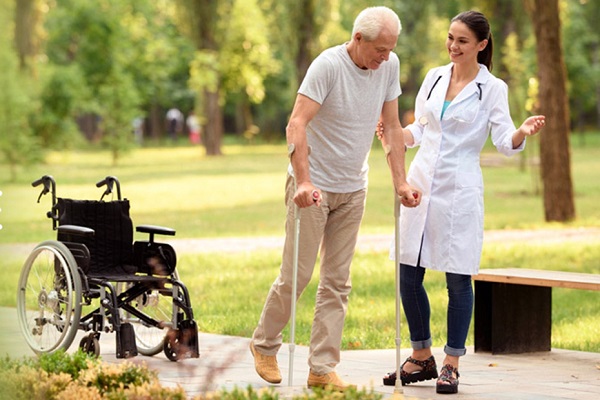
AYURVEDA FOR PARALYSIS
- May 4, 2021
- Posted by Dr. Vaidya Karanvir Singh
- 0 Comment(s)
Table of Contents
INTRODUCTION
In Ayurveda Paralysis has been discussed under Vata vyadhi disorder. In Ayurveda, it is termed as Pakshaghata which means impairment of Karmendriyas/paralysis of one half of the body where “paksha” denotes either half of the body and “Aghata” denotes the impairment of body movements and mental stability.
DEFINITION
Paralysis is a condition where partial or complete loss of function especially when involving the motion or sensation in a part of the body or loss of the ability to move
Partial loss of body function is termed hemiplegia and complete loss of body function is paraplegia.
TYPES OF PARALYSIS
There are many types of paralysis:
- Facial Paralysis – loss of strength and mobility of facial muscles.
- Monoplegia – loss of strength of one limb.
- Hemiplegia – affecting one side of the body such as the leg and arm of the same side of the body.
- Paraplegia – Paralysis of both legs and sometimes parts of the trunk.
- Quadriplegia – affects both arms and both legs
CAUSES OF PARALYSIS
There are many reasons for this condition. The most common reasons are:
- Uncontrolled High Blood Pressure.
- Head Injury Due to Trauma or Accident
- Severe Brain Infection
- Brain Tumors
- Cerebral Haemorrhage
- Shock
CLINICAL FEATURES
- In severe cases of paralysis bowel and Bladder may be affected
- Impaired movement of hands and legs.
- Instability mental function.
- Speech may be affected (slurred speech)
- Temporary loss of vision in one or both eyes or blurry vision.
- Difficulty in swallowing
- Headache
- Unable to understand
- Rapid unintentional eye movement.
- Whole-body fatigue, light-headedness, or vertigo
- Walking difficulty and numbness in limbs
- In case of facial paralysis dropping of eyelid and mouth deviation are seen
DIAGNOSTIC CRITERIA FOR PARALYSIS
Identifying and diagnosing external paralysis is easy as there’s a clear loss of movement and muscle function in a body part. For internal body parts where paralysis is more difficult to identify, your physician may use some imaging studies such as-
- X-Rays
- MRI (Magnetic Resonance Imaging)
- CT-SCAN
- Myelography
- Electromyography (EMG)
- Spinal Tap
MANAGEMENT IN AYURVEDA
AYURVEDIC MEDICINE FOR PARALYSIS
Traditional medicines in the form of crude herbal extracts of a single plant or combination of plants, with or without additional minerals have been used in alleviating and curing disorders related to problems of the nervous system, some of which includes:
Herbs like:
- Ashwagandha (Withania Somnifera)
- Brahmi (Bacopa Monnieri)
- Eranda (Ricinus Communis
- Rasona (Allium Sativum)
- Rasna (Pluchea Lanceolata)
Medicines like:
- Dashmoola Arista
- Sarasawathaarista
- Bhihat vata Chintamani
- Ekangavira rasa
- Mahavatavidwamsana
- Balarista
- Sacharadi kasahya
- Gandarwahastadi qwatha
PANCHAKARMA FOR PARALYSIS
Paralysis can be treated by Panchakarma which is one of the significant treatment modalities of Ayurveda. Panchakarma means five procedures, which are as follows:
- Vamana (therapeutic emesis)
- Virechana (purgation)
- Asthapanvasti (enema using medicated decoction)
- Anuvasanvasti (enema using medicated oil)
- Shirovirechan /Nasya (nasal administration of medicines).
Along with these five major procedures there are various other allied therapies such as oleation (snehana), perspire (swedana) are also overall comes under panchakarma.
- Snehana (Oleation)treatment like massage, Kayaseka, Shirodhara, Shirobasti, Pichu etc with medicated oils followed by different modalities of Medicated fomentation for 7 – 21 days.
- Abhayanga (Massage)with symptom specific medicated oils followed by medicated fomentation helps to increase circulation also strengthens the muscles and nerves.
- Virechana (Purgation) – To increase the Metabolism, to relieve constipations, strengthens the gut, also helps to improve the functioning of the nerves in the affected area.
- Basti(Enema) in the form of Matra Basti, Anuvasana Basti, Nirooha Basti for the period of 8 – 32 days.
- Medicated enema helps in nourishing, strengthening, and also stabilizing the overall functions of the body functioning and this treatment takes a major role in healing the paralytic patient.
- Nasya karma for 7 – 9 days -Therapy helps to strengthen the muscles, nerves and circulation above the shoulder.
- Panchakarma has no side effects and it is more useful in treating neurological diseases as well as paralysis.
“The Procedure such as Patra pinda Sweda, Shashtika shali pinda Sweda, Anuwasana Basti, Shirodhara, Shiro Basti, Sarvanga Abhyanga helps in nerve strengthening and increases blood circulation in affected areas, that helps to fasten and progress the movements”.
PATHYA-APATHYA FOR PARALYSIS
- Avoid food items that are spicy, astringent and oily/fatty food.
- Include foods that are sweet, sour, and salty.
- Avoid incompatible diet (Viruddhahara), bengal gram, peas, potato etc.
- Use onion, garlic, ginger, black gram, horse gram, radish, ash gourd, green gram etc in regular diet.
- Pomegranate, grape or papaya fruits are very useful in paralysis
- Carrot, beetroot, okra, and asparagus should be part of your daily diet.
- Intake high fiber food items as advised by the physician.
- Control the treatable risk factors like diabetes mellitus, hypertension, heart diseases.
- Practice regular exercises or physiotherapy.
- Avoid excessive fasting
- Avoid excess exercises, suppressing natural urges.
- Avoid alcohol consumption and smoking.
- Be active and optimum use of the affected parts.

Dr. Vaidya Karanvir Singh is the younger Vaidya in Chandigarh Ayurved & Panchakarma Centre. He is the fourth generation in his family who is practicing as a general consultant in Ayurved & Panchakarma treatment at Chandigarh. In his practice, he had treated more than 1 Lakh Plus patients worldwide.

